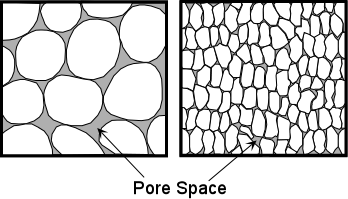Porosity is one of rock important rock properties and it is a measure of pore space in a rock.

Figure 1 – Porosity
(Ref: http://www.tulane.edu/~sanelson/images/pores.gif)
Figure 1 shows the illustration of porosity and it can be seen that grain size and distribution can affect porosity of rock.
Porosity (ɸ) is mathematically expressed as a ratio of total void space with a rock to a total volume of rock.
Porosity (ɸ) = (Vp ÷ Vb) × 100
Where;
Vp = pore volume
Vb = bulk volume of rock
Porosity (ɸ) is shown in percentage form.
How To Measure Porosity
There are several methods to determine porosity as listed below
- Direct methods: measurement from core flush by fluid or air
- Indirect methods: well logging tools (density, neutron, and sonic)
Porosity (ɸ) can be classified into several types based on criteria;
Primary porosity: this is porosity in rock that was formed during sedimentation. Primary porosity depends on several factors, such as depositional environment, grain size & shape, distribution of sand grain, cementation between sands, etc.
Secondary porosity: This is formed during rock diagenesis. Chemical reaction dissolves rock grains and it results in void spaces in the rock.
Absolute porosity: It is a ratio of total pore space to a rock bulk volume. This will not account for voids which don’t connect to others.
Effective porosity: It is a ration of interconnected pore spaces to a rock bulk volume. This is a proper figure to use to calculate fluid volume in a reservoir
Example: A core sample is 5 cm long and 3 cm diameter. In the lab, vacuum, 3.25 cm3, of air is removed from the pore spaces.
1. What is the bulk volume of the core sample?
Bulk volume = (π÷4) × Diameter2 × Core Length
Bulk volume = (π÷4) × 32 × 5
Bulk volume = 35.34 cm3
2. What is the pore volume?
This is the volume of air vacuumed so pore space is 3.52 cm2
3. What is the porosity of the rock?
Porosity (ɸ) = (Vp ÷ Vb) × 100
Porosity (ɸ) = (3.52 ÷ 35.34) × 100
Porosity (ɸ) = 10 %
4. Is it effective or total porosity?
This is effective porosity because it measures volume of air that can be removed from the core.
References